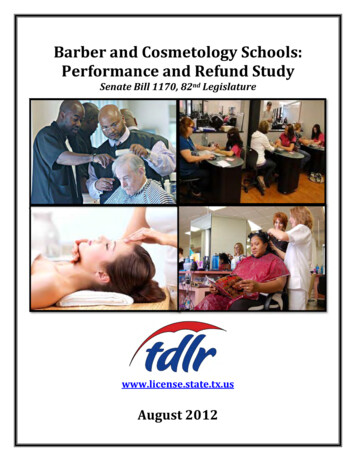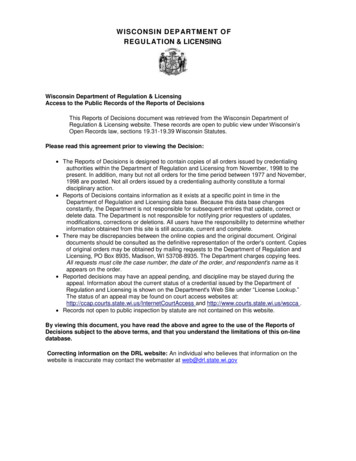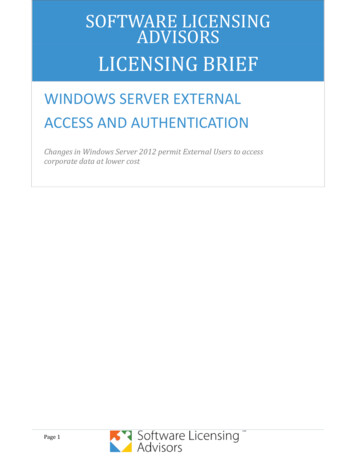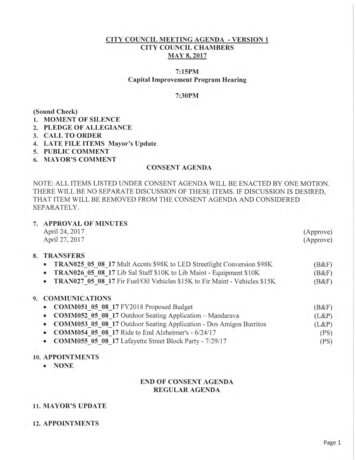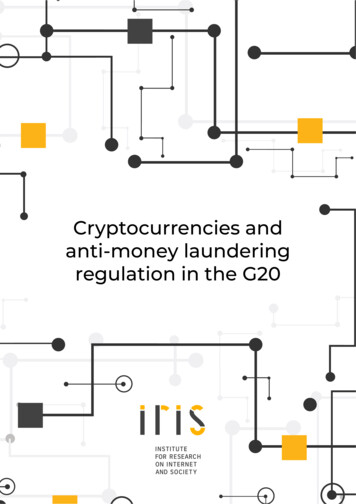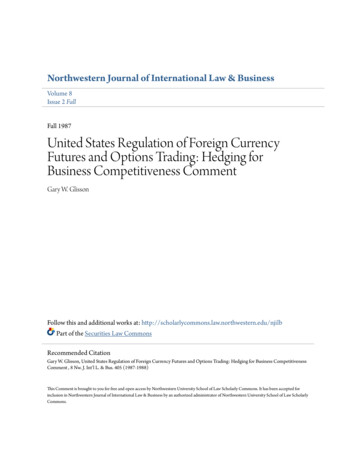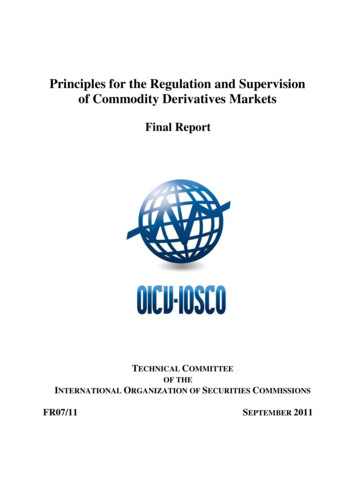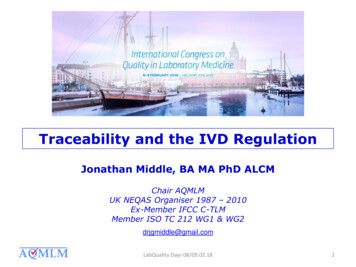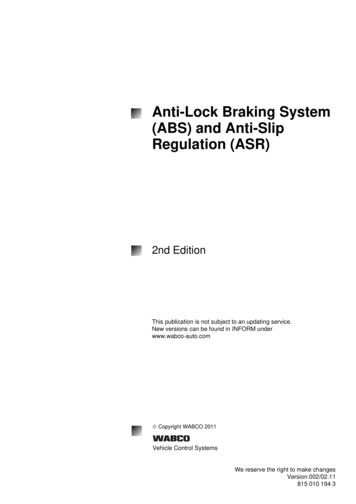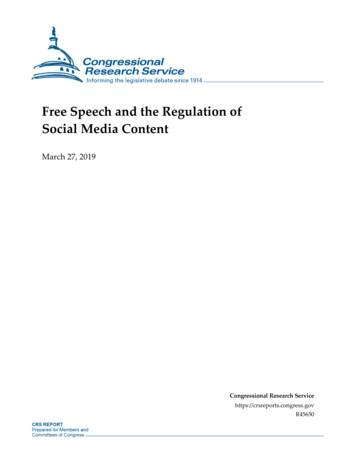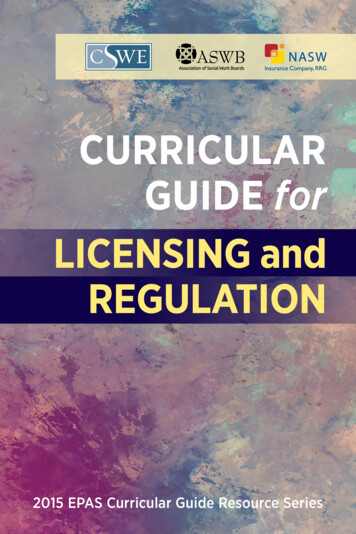
Transcription
CURRICULARGUIDE forLICENSING andREGULATION2015 EPAS Curricular Guide Resource Series
CURRICULARGUIDE forLICENSING andREGULATION
CURRICULARGUIDE forLICENSING andREGULATION2015 EPAS Curricular GuideResource SeriesCouncil on Social Work EducationAlexandria, Virginia
Copyright 2018, Council on Social Work EducationPublished in the United States by the Council on Social Work Education, Inc. All rightsreserved. No part of this book may be reproduced or transmitted in any mannerwhatsoever without the prior written permission of the publisher.ISBN 978-0-87293-199-2Council on Social Work Education1701 Duke Street, Suite 200Alexandria, VA 22314-3457www.cswe.org
AcknowledgmentsThis guide was developed through the generous support of theAssociation of Social Work Boards (ASWB), NASW Risk RetentionGroup (RRG) and the Council on Social Work Education.STEERING COMMITTEECHAIRSAnwar Najor DurackWayne State UniversityDeana F. MorrowWest Virginia UniversityJoseph T. MonahanMonahan Law GroupNancy L. SidellMansfield UniversityHeidi NieuwsmaUniversity of MaryAmanda Duffy RandallUniversity of NebraskaNATIONAL TASKFORCESTEERING COMMITTEEVelva Taylor SpriggsCoppin State UniversityAnn-Marie BuchananLincoln Memorial UniversityAlejandro L. ZamoraCollege of Western IdahoYvonne ChaseUniversity of AlaskaDianna Cooper-BolinskeyCapella Universityv
viCURRICULAR GUIDE FOR LICENSING AND REGULATIONNATIONAL TASKFORCETiffany AdamsonThe University of OklahomaAnne AdcockCampbellsville UniversityWendy AndersonUniversity of Minnesota, DuluthBrenda J. BarnwellAurora UniversityKelly BassUniversity of South DakotaAnthony A. Bibus IIIAugsburg UniversityCarl BrunWright State UniversityTamara CadetSimmons CollegeKhalilah Louis CainesSaint Leo UniversityJose CarbajalStephen F. Austin State UniversityMichael R. DaleyTexas A&M University, Central TexasCassandra DanielsDaemen CollegeSusan Cutler EgbertUtah State UniversityMarc V. FelizziMillersville UniversityKelli S. FoxUniversity of New EnglandPamela FoxUniversity of Texas, ArlingtonJana FryeMissouri Western State UniversityCornelia Gordon-HempeUniversity of Wisconsin, OshkoshDorothy GreeneEast Tennessee State UniversityJ. Christopher HallUniversity of North Carolina,WilmingtonPamela J. HugginsSaint Louis UniversityTanisha R. JamesUniversity of North Carolina, CharlotteShakira A. KennedyTouro CollegeFrances Bernard KominkiewiczSaint Mary’s CollegeEmily Blackmer De MelAzusa Pacific UniversitySandra KopelsUniversity of Illinois,Urbana-ChampaignEileen A. DomboCatholic University of AmericaPaul KurzmanHunter CollegeEleanor Pepi DowneyLewis–Clark State CollegeSara LichtenwalterGannon UniversityKim S. DowningElizabeth City State UniversityCindy E. LocklearThe University of North Carolina,PembrokeBrenda J. EastmanEast Carolina UniversityRobert G. MaddenUniversity of Saint Joseph
AcknowledgmentsNATIONAL TASKFORCE(continued)Tiffany WelchMansfield UniversityJames MarleyLoyola UniversitySky WesterlundFort Hays State UniversityEunice Matthews-ArmsteadEastern Connecticut State UniversityShanika WilsonNorth Carolina Central UniversityKatie McCarthyIndiana UniversityTeresa L. YoungTexas A&M University, KingsvilleJanet MelcherUniversity of CincinnatiMichaela L. Zajicek-FarberCatholic University of AmericaJustin MillerUniversity of KentuckyL. Alee MooreSoutheast Missouri State UniversitySudershan PasupuletiThe University of Texas, Rio GrandeValleyKiana L. PeoplesSouthern Arkansas UniversityRoxroy A. ReidWalden UniversityTelvis RichKean UniversityviiCOUNCIL ON SOCIALWORK EDUCATIONDarla Spence CoffeyPresident and CEOJo Ann Coe ReganVice President of EducationAndrea BediakoAssociate Director, Education Initiativesand ResearchElizabeth SimonPublications ManagerMelanee SinclairBethany CollegeASSOCIATION OFSOCIAL WORK BOARDSLeticia Villareal SosaDominican UniversityMary Jo MonahanChief Executive OfficerKate Morrissey StahlUniversity of GeorgiaJanice FittsEducation & Training Senior Manager
ContentsAcknowledgments . . . . . . . . . . . . . . . . . . . . . . . . . . . . . . . . . . . . . . . . . . . . . . . . . . . . . . . vPreface . . . . . . . . . . . . . . . . . . . . . . . . . . . . . . . . . . . . . . . . . . . . . . . . . . . . . . . . . . . . . . . . xiiiIntroduction . . . . . . . . . . . . . . . . . . . . . . . . . . . . . . . . . . . . . . . . . . . . . . . . . . . . . . . . . . . xviiCompetency 1Demonstrate Ethical and Professional Behavior . . . . . . . . . . 1Appendix 1A Activities Related to Ethics and Licensing Usedin Micro Practice Class . . . . . . . . . . . . . . . . . . . . . . . . . . . . . . . . . . . . . 11Appendix 1BLicensure Discussion Questions . . . . . . . . . . . . . . . . . . . . . . . . . . . . 12Appendix 1CBrain-Teaser Case: Morgan Turns Her Life Around . . . . . . . . . . . . 14Appendix 1DScavenger Hunt Assignment . . . . . . . . . . . . . . . . . . . . . . . . . . . . . . . 15Appendix 1EApplication of an Ethical Decision-Making Model . . . . . . . . . . . . . 17Appendix 1F Assignment: Compare Aspirational Codes of Ethics andObligatory Codes of Conduct Found in Licensing Laws . . . . . . . .18Appendix 1GIntro to Practicum: Pretest on Social Work Licensure . . . . . . . . . .19Appendix 1HField Assignment: Case Scenario Ethical Dilemma . . . . . . . . . . . . 19Competency 2Engage Diversity and Difference in Practice . . . . . . . . . . . . . 21Competency 3 dvance Human Rights and Social, Economic,Aand Environmental Justice . . . . . . . . . . . . . . . . . . . . . . . . . . . . . 29Appendix 3AAssignment and Field Education Learning . . . . . . . . . . . . . . . . . . . 38ix
xCURRICULAR GUIDE FOR LICENSING AND REGULATIONCompetency 4 ngage in Practice-informed ResearchEand Research-informed Practice . . . . . . . . . . . . . . . . . . . . . . . . 41Appendix 4AClass Activity . . . . . . . . . . . . . . . . . . . . . . . . . . . . . . . . . . . . . . . . . . . . 48Appendix 4BBefore the Board of Clinical Social Workers . . . . . . . . . . . . . . . . . 50Competency 5Engage in Policy Practice . . . . . . . . . . . . . . . . . . . . . . . . . . . . . . . 57Appendix 5ACase Scenario for Ethical Practice in a Community Agency . . . . 65Appendix 5BPolicy Presentation . . . . . . . . . . . . . . . . . . . . . . . . . . . . . . . . . . . . . . 66Competency 6 ngage With Individuals, Families, Groups,EOrganizations, and Communities . . . . . . . . . . . . . . . . . . . . . . . 67Appendix 6A In-Class Activity: Engaging Clients and Social WorkLicensure Jeopardy . . . . . . . . . . . . . . . . . . . . . . . . . . . . . . . . . . . . . . . 72Appendix 6B In-Class Activity: Ethics and Engagement Case Scenarios . . . . . 73Appendix 6C Friend and Follow Request . . . . . . . . . . . . . . . . . . . . . . . . . . . . . . . 80Appendix 6D In-Class Activity: Social Media and Social Work Debate . . . . . . . 83Appendix 6E In-Class Activity: NASW Code of Ethics ComparedWith Licensing Laws and Rules . . . . . . . . . . . . . . . . . . . . . . . . . . . . 84Appendix 6F Field Activity: Field Agency Review of LicensingLaws and Rules . . . . . . . . . . . . . . . . . . . . . . . . . . . . . . . . . . . . . . . . . . 85Competency 7 Assess Individuals, Families, Groups,Organizations, and Communities . . . . . . . . . . . . . . . . . . . . . . . 87Competency 8 Intervene With Individuals, Families, Groups,Organizations, and Communities . . . . . . . . . . . . . . . . . . . . . . . 93Appendix 8AExample Case Vignettes for Group Assignment . . . . . . . . . . . . . 99Competency 9 valuate Practice With Individuals, Families,EGroups, Organizations, and Communities . . . . . . . . . . . . . . 101Appendix 9A Purpose of These Classroom Activities . . . . . . . . . . . . . . . . . . . . . 108
ContentsxiAppendix 9B Competency Application With Licensing Integration:Group or Individual Learning Activity in a Practiceor Program Evaluation Course . . . . . . . . . . . . . . . . . . . . . . . . . . . . . 111Appendix 9C Case Scenario 1: Evaluation of the State Social WorkLicensing Board . . . . . . . . . . . . . . . . . . . . . . . . . . . . . . . . . . . . . . . . . 112Appendix 9D Case Scenario 2: Lobbying to Require LicensedSocial Workers to Be Employed by the State as aState Child Welfare Agency . . . . . . . . . . . . . . . . . . . . . . . . . . . . . . 113Appendix 9E Competency Application With Licensing Integration:Group or Individual Learning Activity in a Practiceor Program Evaluation Course . . . . . . . . . . . . . . . . . . . . . . . . . . . . 114
PrefaceCOMPETENCY-BASED EDUCATIONIn 2008 CSWE adopted a competency-based education framework for itsEPAS. Competency-based education rests on a shared view of the nature ofcompetence in professional practice. Social work competence is the ability tointegrate and apply social work knowledge, values, and skills to practice situations in a purposeful, intentional, and professional manner to promote humanand community well-being. EPAS recognizes a holistic view of competence;that is, the demonstration of competence is informed by knowledge, values,skills, and cognitive and affective processes that include the social worker’scritical thinking, affective reactions, and exercise of judgment regarding uniquepractice situations. Overall professional competence is multidimensional andcomposed of interrelated competencies. An individual social worker’s competence is seen as developmental and dynamic, changing over time in relationto continuous learning (CSWE, 2015, p. 6).Competency-based education is an outcome-oriented approach to curriculum design. The goal of the outcome approach is to ensure that students candemonstrate the integration and application of the competencies in practice. Inthe EPAS, social work practice competence consists of nine interrelated competencies and component behaviors that consist of knowledge, values, skills, andcognitive and affective processes. Using a curriculum design that begins with theoutcomes, expressed as the expected competencies, programs develop the substantive content, pedagogical approach, and educational activities that providelearning opportunities for students to demonstrate the competencies (CSWE,2015, p. 6).xiii
xivCURRICULAR GUIDE FOR LICENSING AND REGULATIONSOCIAL WORK COMPETENCIESThe 2015 EPAS stipulates nine competencies for the social work profession.These competencies apply to both generalist and specialized practice. Thenine social work competencies are listed in the 2015 EPAS on pp. 7–9. Each ofthe nine social work competencies is followed by a paragraph that describesthe dimensions (knowledge, values, skills, and cognitive and affective processes) that make up the competency at the generalist level of practice. Thisparagraph informs the content that should be reflected in the generalist socialwork curriculum and represents the underlying content and processes thatinform the behaviors.The bullet points under the paragraph descriptions in the EPAS are a setof behaviors that integrate the dimensions of the competency and representobservable components of each competency. The dimensions of the competency inform the behaviors.SPECIALIZED PRACTICEThe 2015 EPAS stipulates nine competencies for the social work profession.These competencies apply to both generalist and specialized practice. Thenine social work competencies are listed in the 2015 EPAS on pp. 7–9. Each ofthe nine social work competencies is followed by a paragraph that describesthe dimensions (knowledge, values, skills, and cognitive and affective processes) that make up the competency at the generalist level of practice. Thisparagraph describes the content that should be reflected in the generalistsocial work curriculum and represents the underlying content and processesthat inform the behaviors. The bullet points under the paragraph descriptionsin the EPAS are a set of behaviors that integrate the dimensions of the competency and represent observable components of each competency. The dimensions of the competency inform the behaviors.FRAMEWORK FOR THE GUIDEThe CSWE Commission on Educational Policy (COEP) developed a frameworkfor the development of curricular guides for areas of specialized practice. Thetaskforce followed the guidelines for creating licensing and regulation competencies and curricular resources listed here:
Prefacexv1) Identification of an area of specialized practice for a specific population,problem area, method of intervention, perspective, or approach to practice in social work (Educational Policy [EP] M2.1).2) Discussion of how the area of specialized practice builds on generalistpractice as described in EP 2.0 (Accreditation Standard [AS] M2.1.1).3) Identification of the specialized knowledge, values, skills, cognitive andaffective processes, and behaviors that extend and enhance the ninesocial work competencies and prepare students for practice in the areaof specialization identified (EP M2.1 and AS M2.1.3).4) Suggested curriculum content and resources (e.g., readings, multimedia and online resources, modules, assignments, experiential exercises,class and field activities) for each of the nine social work competenciesand any additional competencies identified. The curriculum content andresources identified in this guide are not required by accreditation standards and are meant to serve as an optional guide to programs on howto conceptualize trauma-informed social work practice with the ninesocial work competencies identified in the 2015 EPAS.5) Identification of the competency dimensions (knowledge, values, skills,and cognitive and affective processes) associated with the course content for each competency.This guide highlights licensing and regulation content for social work curricula and can be used with generalist or specialized practice curricula. Theguide provides resources for educators desiring to expand this content withintheir baccalaureate and master’s programs and courses.
IntroductionIn 2014 the Association of Social Work Boards (ASWB) developed the Pathto Licensure program as a resource to aid social work educators in preparingstudents for their careers as licensed professional social workers. The Pathprogram offers resources to social work educators designed to strengthenthe faculty and student knowledge of professional regulation including anonline laws and regulations database, an online group practice test to use as ateaching tool, and periodic newsletters. The program offers consultation at nocharge to social work education programs to help them customize a plan foreducating students about professional licensure and regulation.When CSWE began to produce the curricular guides, it occurred to ASWBthat this resource could be an opportunity to help educators better understandthe relationship between the EPAS competencies and social work regulation.ASWB began a conversation with CSWE about this possibility. After observingthe development process of one of the other guides, ASWB volunteered tosponsor a Licensing and Regulation Guide and invited NASW Insurance RiskRetention Group (RRG) to join in that sponsorship. RRG specializes in helpinglicensed social workers evaluate and manage risk in their professional practicewhich is a good match for this project.In the fall of 2017, CSWE issued an invitation to all accredited schools of socialwork asking for volunteers to create a task force to work on the Licensing andRegulation Curricular Guide. The sponsors and CSWE also selected a steering committee of two co-chairs, Deana Morrow, Ph.D. and Nancy Sidell, Ph.D.and nine members to lead this project. Each of the nine steering committeexvii
xviiiCURRICULAR GUIDE FOR LICENSING AND REGULATIONmembers chaired a committee of task force volunteers in developing the EPAScompetency descriptions, behaviors, and resources.A total of 63 volunteers were engaged in this project. This includes 52 taskforce members and 11 steering committee members who were able to complete the project. Of the 63 volunteers, 58 are licensed social workers, 2 arelicensed attorneys, and 3 and not licensed. Twelve volunteers have served onlicensing boards.The work started January 3, 2018 with a virtual meeting to orient steeringcommittee members and organize assignments. On January 25, 2018 a webinar with the task force was held with 38 members who were able to attend.The committees began to meet right away to draft competency descriptionsand behaviors that reflected how professional licensing and regulation relatedto each standard.April 17-18, 2018 CSWE hosted an in-person meeting of the task force andsteering committee in Alexandria, Virginia. Thirty-nine volunteers plus ASWBand CSWE staff were able to attend. This meeting represented 624 hours ofwork by volunteers on the project. After the in-person meeting in April, thevolunteers had a greater appreciation of the importance of this task, the needfor licensure and regulation knowledge for both colleagues and students, andcommon regulatory language.The task force committees used a variety of ways to work on their chapters.More than 40 videoconference meetings and conference calls took place representing more than 217 hours of time by volunteers. In addition, a rough estimate of hours of work between meetings by volunteers exceeded 264 hours.The committees used a variety of document sharing methods to gather ideasand edit drafts including the use of Google Docs and Dropbox. The steeringcommittee co-chairs reviewed all chapter drafts and researched and wrote theintroduction representing another 80-plus hours of work. In sum, more than1,225 hours were spent on completing this project.ASWB through the Path to Licensure Program is committed to assistingin the implementation of the ideas and activities presented in this Licensureand Regulation Curricular Guide. Students need to understand the three basicrequirements to become professional licensed social workers: the “3 E’s” ofeducation, experience, and exam. This interconnectedness of social work
Introductionxixeducation, practice and regulation supports students in the development ofprofessional identity and commitment to life-long prudent practice. CSWE,ASWB and NASW Risk Retention Group are committed to supporting safe,competent, and ethical social work practice and we believe this curricularguide is an essential tool for guiding the education of students who are aspiring social workers.PURPOSE OF THE GUIDEThe purpose of this guide is to provide social work educators content information and strategies for educating students about social work licensure andregulation. The guide is designed to facilitate the integration of licensure andregulation education throughout social work curricula and programming. Itcan also be used a resource to build student knowledge and reduce apprehension about the licensing process and social work regulation.This guide is not intended as a licensure exam preparation tool. Educatorsseeking to help students understand the exam process are referred to theAssociation of Social Work Boards (ASWB) website at www.aswb.org for themost current information about the various exams.Most importantly, this guide is designed to encourage social work educators, students, and practitioners to join together to ensure the protectionof public consumers of social work services through licensed and regulatedpractice.HISTORY OF SOCIAL WORK LICENSURE AND REGULATIONIn 1915 Abraham Flexner asserted that an academic degree in itself did notdesignate social work as a profession; something more was needed (Flexner,1915/2001). In professions such as medicine, law, teaching, nursing, psychology,and now social work, that something is a license to practice.Regulation of the social work profession has been slower to emerge thanthat of other professions. For example, physicians were regulated in all statesby 1900, teachers by 1930, and attorneys and dentists by 1940 (Law & Kim,2005). The first legislative action toward social work licensure action occurredin 1934 when Puerto Rico began regulating social work practice (Bibus &Boutté-Queen, 2011). California became the first U.S. jurisdiction to pursue
xxCURRICULAR GUIDE FOR LICENSING AND REGULATIONlicensure when its legislature established social work practice regulation in1945 (Bibus & Boutté-Queen, 2011). Social work regulation legislation progressed slowly in the 1950s under a presumption by some that, because thepublic received services primarily through public agencies, protections wereafforded through agency oversight, supervision, and professional commitmentto the National Association of Social Workers (NASW) Code of Ethics (Bibus& Boutté-Queen, 2011). Gradually, it became clear that these protections werenot sufficient. NASW (1974) called for the regulation of social work practicein the 1970s. Responding to the growing call for regulation of practice, theAmerican Association of State Social Work Boards, now known as ASWB, wasfounded in 1978 by 23 people representing 12 states. As a nonprofit association dedicated to social work regulation, ASWB offered the first licensingexamination in 1983 to 464 social workers practicing in New York, Virginia,and Oklahoma (ASWB, 2018c). From these modest beginnings, social workregulation has evolved into its modern-day status.CONTEMPORARY LICENSURE AND REGULATIONLicensure in social work represents an externally validated level of competenceachieved by attaining a degree, passing an examination, obtaining supervisedexperience depending on category of licensure, and being held accountable tothe public for ethical and competent practice. Licensure is an earned privilegeand has become the hallmark of social work as a profession where protectionof the public from harm and unscrupulous practice is warranted.Social work practice regulation in North America is instituted by state jurisdiction in the United States and by provincial jurisdiction in Canada, rather thanat the federal level. These jurisdictions hold the authority to regulate practicewithin their boundaries (Bibus & Boutté-Queen, 2011). Because of jurisdictionvariations in regulation standards, social work licensure has been describedas a “patchwork quilt of terminology and requirements” (Collins, Coleman,& Miller, 2002, p. 205) and a “many-splendored thing,” with each jurisdictiongoing “its own way” (Seidl, 2000, p. 194). ASWB currently reports 56 varietiesof licensing titles across jurisdictions (ASWB, 2018e). Despite the variation inrequirements and license titles, all jurisdictions share a common purpose: “To
Introductionxxiestablish in statute a set of legally enforceable minimum standards to whichsocial work licensees are held accountable” (Seidl, 2000, p. 1).ASWB administers more than 50,000 exams annually across five examination categories (ASWB, 2018f). There are more than 530,000 licensed socialworkers across the ASWB member jurisdictions: all 50 U.S. states, the District ofColumbia, the U.S. Virgin Islands, Guam, the Northern Mariana Islands, and all 10Canadian provinces (ASWB, 2018a).Gaining and maintaining licensure is, to a large degree, a professional expectation. Even if employers do not require social work employees to be licensed,the regulatory board in nearly all jurisdictions compels it. Bibus and BouttéQueen (2011) assert that licensing reinforces professional identity and signalsthe beginning of an enduring, career-long relationship between the graduatepursuing licensure and the jurisdictional regulatory board overseeing practice.The ASWB Model Social Work Practice Act (ASWB, 2015b) is a resourceguide established to assist jurisdictions in developing practice regulations. Theact delineates the purpose of regulation as protecting the health, safety, andwelfare of the public through effective regulation of social work practice. It alsorecommends categories of licensure, requirements for licensure, standards ofpractice, and composition of licensure boards that oversee the licensing processfor each jurisdiction.Regulation is an example of policy practice within the social work profession. Viewing regulation from a policy framework is germane to understanding, and influencing, regulatory requirements. Regulatory policy guides thepractice of licensed social work. Just as it is the obligation of a social workerto understand policies affecting the client system being served, it is also theresponsibility of the social worker to understand regulatory laws in jurisdictions where services are delivered.FEATURES OF LICENSING AND REGULATIONThere are a number of signature features of licensing and regulation. Forexample, licensure is a practice regulation process that mandates compliancewith professional standards. The primary purpose of regulation to protectthe public. Regulation promotes social justice by ensuring that the public hasaccess to competent services and formal recourse in the event of improper
xxiiCURRICULAR GUIDE FOR LICENSING AND REGULATIONservice. Regulatory bodies support title and practice protection. Regulationincludes identifying and responding to risk management in practice. Finally, anemerging issue in social work regulation is the capacity for practice mobility.Each of these topics will be addressed in this section.Practice RegulationLike other professions, licensed social work practice is guided by practice regulation. That is, social work standards of practice are established legally andmonitored by jurisdictional boards to ensure licensed, competent, and ethicalpractice. In drawing the distinction between voluntary self-regulation and legalpractice regulation, Monahan (2018a) points out that the NASW Code of Ethics(NASW, 2017) is a form of voluntary and aspirational self-regulation of practice. Social workers voluntarily agree to abide by the Code of Ethics as part oftheir membership in NASW, yet adherence to the code has no legal mandatein the absence of practice regulation. Practice regulation goes beyond voluntary self-regulation by legally mandating standards of practice, protection ofthe public, and recourse for violation of practice standards. Monahan furtherasserts, “Through professional regulation, the aspirational goals of the Codeof Ethics become a legal obligation with enforceable accountability for publicprotection” (para. 3). Accordingly, practice regulation creates a legal mandatefor ethical practice and accountability to clients, the profession, and the public.The laws that regulate social work practice are developed at each jurisdictional level (e.g., at the state level in the United States or at the province levelin Canada). The ASWB Model Social Work Practice Act (ASWB, 2015b) guidesstates, provinces, and international jurisdictions in establishing standards ofpractice. Regulatory standards codify license categories, requirements forlicensure, ethical standards for practice, disciplinary actions for violation ofstandards, and requirements for jurisdictional boards that carry out licensing,monitoring of practice, and disciplinary actions. Legal regulation is vital toensuring that licensed social workers are held accountable to standards ofcompetent and ethical practice.Protection of the PublicThe central purpose of legally regulating social work practice is to protect thepublic, the consumers of social work services. The ASWB Model Social Work
IntroductionxxiiiPractice Act (ASWB, 2015b) affirms that social work is “a professional practiceaffecting the public health, safety, and welfare and is subject to regulationand control in the public interest” (p. 3). The act further asserts that, in orderto ensure public trust, only qualified people should be allowed to practicesocial work. Regulatory bodies establish the qualifications for practice, issuelicenses, and monitor the safe and competent practice of social work to protect consumers of services from unethical and unlawful practice.Social JusticeClosely related to protecting the public is the concept of social justice in regulating practice (Monahan, 2018b). Social justice, a core value of the socialwork profession, pertains to pursuing social change “with and on behalf ofvulnerable and oppressed individuals and groups of people” (NASW, 2017,p. 5). Social justice includes ensuring equal access to competent and ethicalsocial work services. It also includes ensuring that the public has a mechanismfor recourse in the event of unscrupulous or incompetent practice.Licensed social workers are held accountable by their jurisdictional boardsfor upholding standards of competent and ethical practice. In keeping with principles of social justice, consumers of social work services have the right to filecomplaints if a licensed social worker violates practice standards. Complaintsare formally investigated and adjudicated by the relevant jurisdictional board.Practice in violation of regulations can result in disciplinary actions such as formalreprimand, probation, suspension, and revocation of a license to practice socialwork (ASWB, 2011). Sanctions are public records and are maintai
social work competencies identified in the 2015 EPAS. 5) Identification of the competency dimensions (knowledge, values, skills, and cognitive and affective processes) associated with the course con-tent for each competency. This guide highlights licensing and
